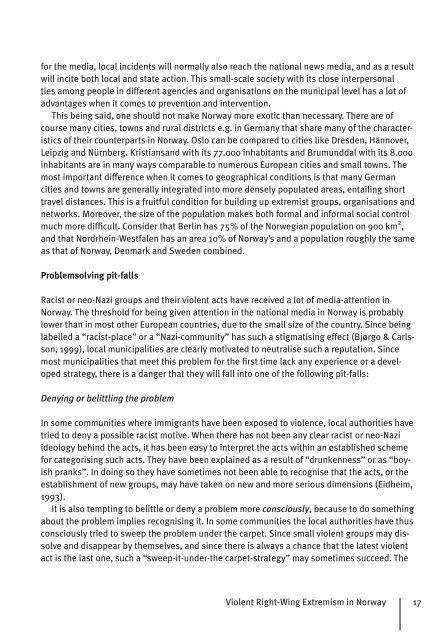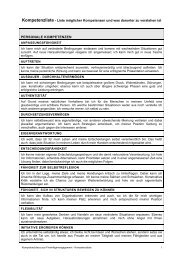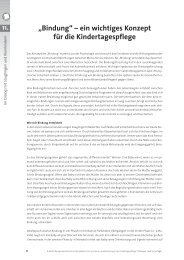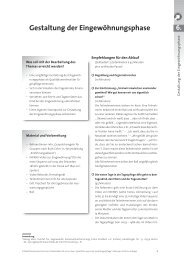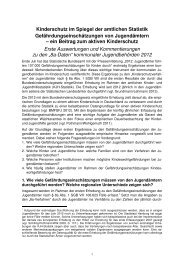Prevention of Right-Wing Extremism, Xenophobia and Racism in ...
Prevention of Right-Wing Extremism, Xenophobia and Racism in ...
Prevention of Right-Wing Extremism, Xenophobia and Racism in ...
You also want an ePaper? Increase the reach of your titles
YUMPU automatically turns print PDFs into web optimized ePapers that Google loves.
for the media, local <strong>in</strong>cidents will normally also reach the national news media, <strong>and</strong> as a result<br />
will <strong>in</strong>cite both local <strong>and</strong> state action. This small-scale society with its close <strong>in</strong>terpersonal<br />
ties among people <strong>in</strong> different agencies <strong>and</strong> organisations on the municipal level has a lot <strong>of</strong><br />
advantages when it comes to prevention <strong>and</strong> <strong>in</strong>tervention.<br />
This be<strong>in</strong>g said, one should not make Norway more exotic than necessary. There are <strong>of</strong><br />
course many cities, towns <strong>and</strong> rural districts e.g. <strong>in</strong> Germany that share many <strong>of</strong> the character-<br />
istics <strong>of</strong> their counterparts <strong>in</strong> Norway. Oslo can be compared to cities like Dresden, Hannover,<br />
Leipzig <strong>and</strong> Nürnberg. Kristians<strong>and</strong> with its 77.000 <strong>in</strong>habitants <strong>and</strong> Brumunddal with its 8.000<br />
<strong>in</strong>habitants are <strong>in</strong> many ways comparable to numerous European cities <strong>and</strong> small towns. The<br />
most important difference when it comes to geographical conditions is that many German<br />
cities <strong>and</strong> towns are generally <strong>in</strong>tegrated <strong>in</strong>to more densely populated areas, entail<strong>in</strong>g short<br />
travel distances. This is a fruitful condition for build<strong>in</strong>g up extremist groups, organisations <strong>and</strong><br />
networks. Moreover, the size <strong>of</strong> the population makes both formal <strong>and</strong> <strong>in</strong>formal social control<br />
much more diffi cult. Consider that Berl<strong>in</strong> has 75% <strong>of</strong> the Norwegian population on 900 km 2 ,<br />
<strong>and</strong> that Nordrhe<strong>in</strong>-Westfalen has an area 10% <strong>of</strong> Norway’s <strong>and</strong> a population roughly the same<br />
as that <strong>of</strong> Norway, Denmark <strong>and</strong> Sweden comb<strong>in</strong>ed.<br />
Problemsolv<strong>in</strong>g pit-falls<br />
Racist or neo-Nazi groups <strong>and</strong> their violent acts have received a lot <strong>of</strong> media-attention <strong>in</strong><br />
Nor way. The threshold for be<strong>in</strong>g given attention <strong>in</strong> the national media <strong>in</strong> Norway is probably<br />
lower than <strong>in</strong> most other European countries, due to the small size <strong>of</strong> the country. S<strong>in</strong>ce be<strong>in</strong>g<br />
labelled a “racist-place” or a “Nazi-community” has such a stigmatis<strong>in</strong>g effect (Bjørgo & Carls-<br />
son, 1999), local municipalities are clearly motivated to neutralise such a reputation. S<strong>in</strong>ce<br />
most municipalities that meet this problem for the fi rst time lack any experience or a devel-<br />
oped strategy, there is a danger that they will fall <strong>in</strong>to one <strong>of</strong> the follow<strong>in</strong>g pit-falls:<br />
Deny<strong>in</strong>g or belittl<strong>in</strong>g the problem<br />
In some communities where immigrants have been exposed to violence, local authorities have<br />
tried to deny a possible racist motive. When there has not been any clear racist or neo-Nazi<br />
ideology beh<strong>in</strong>d the acts, it has been easy to <strong>in</strong>terpret the acts with<strong>in</strong> an established scheme<br />
for categoris<strong>in</strong>g such acts. They have been expla<strong>in</strong>ed as a result <strong>of</strong> “drunkenness” or as “boy-<br />
ish pranks”. In do<strong>in</strong>g so they have sometimes not been able to recognise that the acts, or the<br />
establishment <strong>of</strong> new groups, may have taken on new <strong>and</strong> more serious dimensions (Eidheim,<br />
1993).<br />
It is also tempt<strong>in</strong>g to belittle or deny a problem more consciously, , because to do someth<strong>in</strong>g<br />
about the problem implies recognis<strong>in</strong>g it. In some communities the local authorities have thus<br />
consciously tried to sweep the problem under the carpet. S<strong>in</strong>ce small violent groups may dis-<br />
solve <strong>and</strong> disappear by themselves, <strong>and</strong> s<strong>in</strong>ce there is always a chance that the latest violent<br />
act is the last one, such a “sweep-it-under-the carpet-strategy” may sometimes succeed. The<br />
Violent <strong>Right</strong>-<strong>W<strong>in</strong>g</strong> <strong>Extremism</strong> <strong>in</strong> Norway<br />
17


